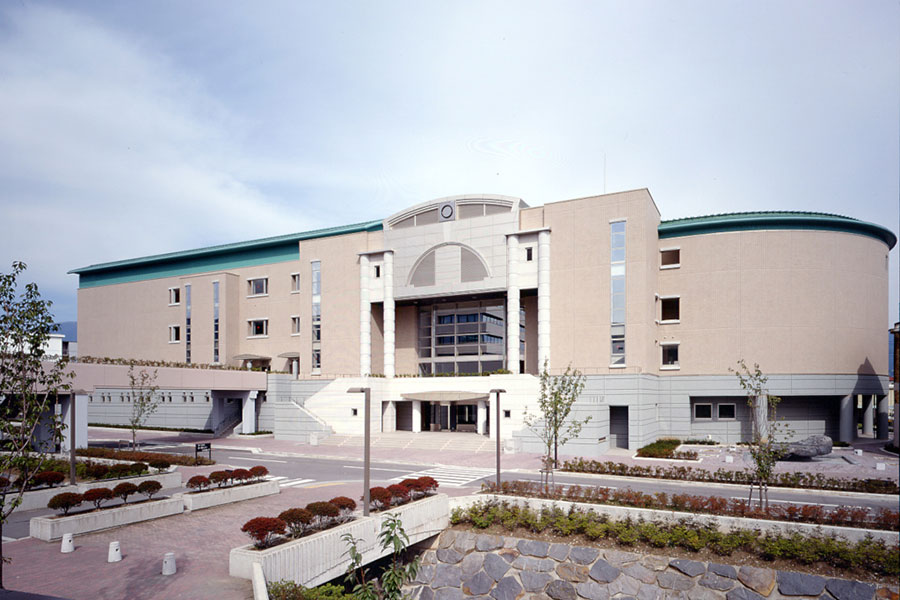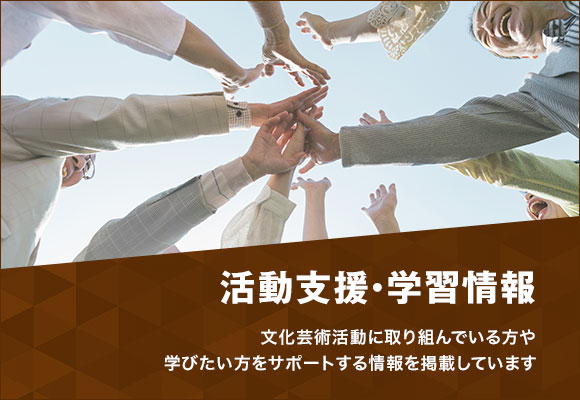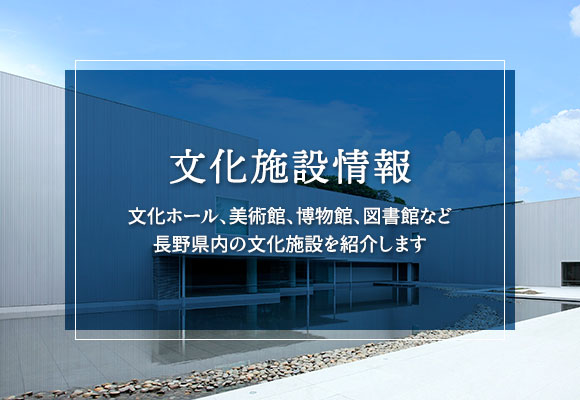
オペラ「御柱」 市民が支える「もう一つの御柱」
長野県諏訪地域で、7年に1度、寅と申の年に行われる伝統神事と言えば、諏訪大社の御柱祭。正式名称を「式年造営御柱大祭(しきねんぞうえいみはしらたいさい)」という全国的にも有名な大祭です。
2022(令和4)年は“御柱年”。諏訪地域の各地で春の大祭だけでなく、さまざまな地域ごとの神事、御柱にちなんだイベントが続いていますが、岡谷市文化会館カノラホールでは11月27日(日)に、御柱年にだけ上演される市民オペラ「御柱」(脚本・作曲:中村透、音楽監督・指揮:山上純司、演出:島田道生)の公演が行われます。1998(平成10)年の初演以来、2004(平成16)年、2010(平成22)年、2016(平成28)年と御柱祭に合わせて上演を重ね、今回で5度目、令和になって初めての公演となります。カノラホールへ、このユニークな取り組みの現場を訪ねました。
 オペラ「御柱」チラシ
オペラ「御柱」チラシ市民と共に、文化創造を高らかに歌い上げる
カノラホールは1989(平成元)年開館。ドイツ・フランクフルトの劇場をモデルにしたというヨーロッパのオペラハウス風の建築は、1400人以上を収容する馬蹄(ばてい)状の客席をもつ大ホールと、さまざまな用途に対応する小ホール、会議室や練習室などを備えています。
ラテン語で高らかに響き渡る様を意味する「カノラ」と名付けられたこの文化施設では、一般への施設貸出と合わせて市民のニーズに沿ったクラシックコンサートや落語、ジャズからポピュラー音楽の公演まで、さまざまな主催事業も行われています。
 ロビー
ロビー 大ホール
大ホール
主催事業の中でも際立つのが市民参加型事業の多さ。1991(平成3)年にはカノラ少年少女合唱団が発足し、小学生から高校生までの子どもたちによる年間を通した練習と発表会が今もなお、続いています。2001(平成13)年にはカノラータオーケストラという市民オーケストラも組織されています。数多くの、一般市民が参加できる公演が行われ、そこから継続的な活動が生まれている貴重な文化施設なのです。
地域ならではの文化的な発信を“地域のちから”で
「地域の皆さんに活用され、愛される、なじみのあるホールでありたいな、というところは一貫しています」とお話くださったのは、オペラ「御柱」が初演された1998(平成10)年にカノラホール職員となり、オペラ「御柱」と共に勤務年数を重ねている、事業課職員の有賀大輔さんです。
 事業課職員の有賀大輔さん
事業課職員の有賀大輔さんオペラ「御柱」は開館5周年の記念事業として1994(平成6)年に着想されました。当初から御柱年に合わせての再演を前提として計画されていたというのが驚きです。
有賀さん
「地域ならではの文化的な発信をしたいという想いがありました。翌年には一般からあらすじを公募して本格的な製作に取りかかっています。当時、下諏訪町在住だった一般の方の案が採用され、その筋を元にして琉球大学名誉教授で作曲家でもある中村透氏に脚本・作曲を委嘱しました。現在は2回目の公演時に改訂された2幕5景の改訂版脚本を使用していますが、初演時は3幕6景、3時間を超える大作でした」
 2016年の台本
2016年の台本本作は、古代のスワ(諏訪)地方に時代を設定した神話オペラです。作品の舞台は諏訪湖を中心に、東西南北に広がる各集落をイメージさせる名の部族が登場し、古事記の国譲り神話の中に出てくるタケミカヅチ、タケミナカタを連想させる人物や、テナガ、アシナガやモレヤなど、諏訪地域に住む人たちであればピンとくるような名前の登場人物が活躍します。
そして、この地域色の強い作品を上演するのに欠かせないのが市民の力です。
有賀さん
「市民合唱団として約90人が参加してくださいます。中には御柱の年ごとに初演から出続けている市民もいます。一番小さいときに『里の子』という役を経験して、高校生になって『風の精』という役を演じ、回を重ねて大人の役で出る、といった感じです」
 1998年の上演
1998年の上演 2010年の上演
2010年の上演
 2016年の上演(フィナーレ場面)
2016年の上演(フィナーレ場面)7年ごとに役割を変えながら関わり続けるのは、本家・御柱祭と同じ。年長者から役割を引き継ぎ、次世代へつないでいきます。
役割を変えつつ関わり続けるのは、ホール職員も同様のようです。カノラホールの役割はいわゆる「制作」と言われるもの。スケジュールを立て、合唱団の窓口になり、プロの方々との調整を行います。ホール側がプロと実行委員会、市民の皆さんのつなぎ役を担っています。
オペラ「御柱」の制作は、ほぼ1年かけて12人の職員総出であたるそうですが、毎回同じ職務に就く訳ではないそうです。通常は縁の下の力持ちですが、有賀さんは、入社したばかりの初演時、出演者としても活躍したというお話まで飛び出しました。
有賀さん
「入ったばかりだったから、ということもあったのでしょうが…研修代わりに、という感じでしょうか。公演の3カ月くらい前かな、当時の館長に呼ばれて『男性が足りないから、ちょっと行って来い』と(笑)」
男声合唱が手厚く必要な場面だけ、昼の勤務を終えてから夜の稽古に参加したのだそうです。舞台に立った感想をお聞きしても「どうだったかなぁ」と笑顔でごまかされてしまいましたが、実は高校から大学まで合唱の経験があったそうですから、当時の有賀さん、案外、久しぶりの舞台出演を楽しまれたのかもしれません。
そんなお話を伺っていると、ホール職員もまた、「地元の人たち」、「地域の市民」なのだと感じます。30数人の実行委員会もホールと共に運営を担い、稽古のサポートから広報業務の協力など、その人が出来る力を発揮している様子に、職員と実行委員の区別はありません。
“市民の力を引き出す”稽古
訪問した日は、市民男性合唱の稽古。本番同様に、大ホールの舞台上で、テープやシートで印を付けて本番の舞台装置をイメージしながら稽古が行われていました。

演出家の島田道生さんと、合唱指導の先生による稽古が進みます。立ち位置を確認しつつ声を出し、どの並びが良いかを検討していきます。パート分けを重視して、グループでまとまるのが良いか、役柄に合わせてグループを作って、物語の見せ方に合わせるのか。
実際に立ち位置を変えて歌ってみると、声がまとまって聞こえたり、逆に散漫な感じになってしまったり、合唱隊の皆さんの力が一番発揮できる立ち位置はどこなのか、演出の島田さんが次々と指示を出して探っていました。
その中にあっても、合唱指導の先生からは「その歌い方では声が下に落ちてしまうよ」、「ピアノに合わせず、指揮に合わせないと舞台の奥行きの兼ね合いで声がまとまらないよ」といった具体的なアドバイスが入り、合唱隊の皆さんも真剣に指導を聞いています。

「素人の合唱だから…」といった甘えは全く感じられません。各パートにはリーダーがいて、変更が入ったことを、遅れて稽古にやって来たメンバーに伝えます。日中の仕事や学校を終えたといった風情の人たちも多く、「仕事を終えてから御柱のために集まる」といった感じも、本家・御柱祭と同じです。
この日の稽古では、最終的には立ち位置が変っていました。
「今の段階ではこの立ち位置ですが、変わる可能性もあります。皆さんが一番力を発揮できるようにとの変更ですので、そのつもりでご理解ください」と島田さんが説明されていたのが印象に残ります。稽古中の雑談で、オペラの現場では、演出家と音楽監督が対立することもある中、この座組は全チーム仲が良いのだ、といった話が出ていました。
オペラ「御柱」に関わるプロ達は市民の力を引き出すことを共通の目標にして、スタッフシャツの背中の文字通り「諏訪は一つ」にまとまっているのです。
引き継がれ、世代を超えて続けられていくもの
取材を通じて、このオペラ公演が単なる参加型公演ではなく、市民が主役の公演であるという印象を強くしました。
有賀さん
「合唱オペラといいますか、ボリューム的にもコーラスパートが非常に多くて、市民合唱がないと成り立たない作品です。既存の作品を使って市民に参加いただくものとは異なります。このオペラに関しては、この地域ならではの題材をモチーフにして、地域の方々の手でやりましょう、という趣旨で成り立ちました。それが、市民が主役であるということにつながっています」
市民に関わりを持ってもらう工夫は随所にみられます。衣装は3回目の再演の際に新しくあつらえた物ですが、これは諏訪市内の高校の服飾デザイン科の学生に一部作成を委託して作られました。
5回目の今回も新たな工夫があり、舞台には市民から集められた古布から作成された幕も使われます。「単に布を集めるだけではなく、円形に切るところまではやっていただいた物を集めました。ひと手間かけてくださると『自分の布』という感じが増すでしょう?」と、1つ1つの工程にも市民参加を促す仕掛けがあるようです。
応募想定を上回り、5000枚もの円形の布地が集まったそうですが、30人のワークショップ参加者の手により、幕は無事に完成したとのことです。
カノラホールにとって、オペラ「御柱」はどんな公演なのでしょう。
「良く続けられているなぁ」という感じですかね、と苦笑いの有賀さんに、率直な想いをお伺いしました。
有賀さん
「いろいろ複雑なところはあるかもしれないです。オペラ公演をやるとなると、財政的なものも含めて、たくさんの支援が必要です。行政の理解も必要ですし、関係者には、協賛という形で応援してくださる地元の企業もあります。もちろん国からの助成金も得ながらやっています。このオペラは『御柱』という名前を使っていますけれど、諏訪大社にもお認めいただきながらの事業です。各所からのお力添えや理解を得つつの事業。そうなると、やっぱり、印象としては『よく続いているなぁ』と」
“お祭り”は、大変な準備期間と多数の人手を要し、経済的な負担もあります。長い準備の期間、楽しいことばかりではないのかもしれませんが、やはりお祭り当日は諏訪人の血が騒ぎます。大祭はそのようにして、7年ごとに引き継がれ、世代を超えて続けられていくのでしょう。
たくさんの市民の力が集まった、諏訪地域ならではの文化を感じられる公演になりそうです。11月の本番を拝見することが、ますます楽しみになりました。
取材・文・撮影(稽古場):石田名保子
撮影(インタビュー):タナカラ
オペラ「御柱」
2022年11月27日(日)
開演:14:00(開場:13:15)
料金[自由席]一般、ソサエティ会員 3,000円 小中高生 1,000円

岡谷市文化会館(カノラホール)
岡谷市幸町8-1




 ロビー
ロビー 大ホール
大ホール 1998年の上演
1998年の上演 2010年の上演
2010年の上演

















